© Wakayama Prefecture Tourism Federation Located in Shingu City, Wakayama Prefecture, Kumano Hayatama Taisha is one of the three sacred shrines of the Kumano Sanzan and serves as the head shrine of approximately 5,000 Kumano Shrines across Japan. The area was named "Shingu" (meaning New Shrine), when the new shrine was established here. This sacred site has long been rooted in the land and has drawn worshippers across the ages.
2025.10.17-
Table of Contents
- World Heritage Site: Kumano Hayatama Taisha
- Festivals of Kumano Hayatama Taisha
- The Source of Prayer Revealed Through the Kumano Sanzan Pilgrimage
World Heritage Site: Kumano Hayatama Taisha
The First Descent of the Kumano Deities
The associated shrine, Kamikura Shrine — part of Kumano Hayatama Taisha — is believed to be the place where the three main deities of Kumano first descended to earth, marking the beginning of Kumano’s spiritual history. These deities are:
Around the 58th year of Emperor Keikō’s reign (estimated mid-4th century), a vivid vermilion shrine was built at the mouth of the Kumano River, enshrining Hayatama-no-Ōkami and Fusumi-no-Ōkami as the main deities. This became the present-day Kumano Hayatama Taisha. By the late Heian period (late 12th century), the shrine of the Twelve Gongen was established, and the current Kumano Hayatama Taisha came to be known as “Shingu” in contrast to the original site of Kamikura Shrine. The name “Shingu” remains as a place name and continues to welcome many worshippers.
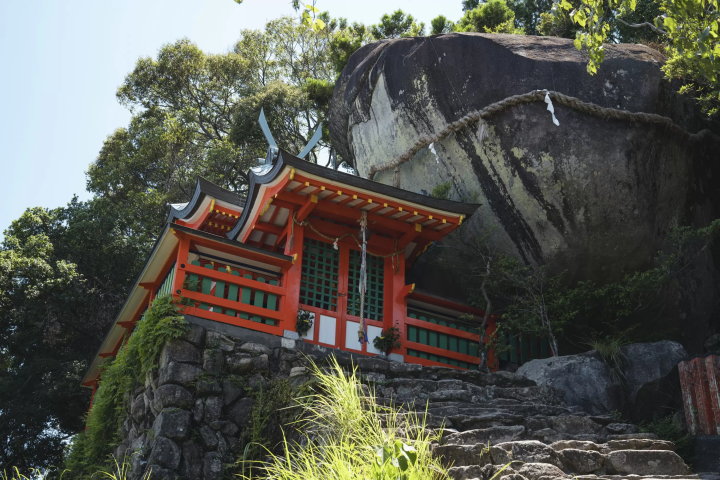
The huge rock "Gotobiki Rock" that stands in the grounds of Kamikura Shrine has been worshipped as a sacred object of the gods since ancient times. Before shrine buildings existed, this area was in an era of "nature worship," where people worshiped nature itself, and the rock itself was considered sacred.
Legend has it that Emperor Jimmu, the first emperor of Japan, was awarded the sacred sword "Tsurugi no Tsurugi" by a local powerful clan member, Takakuraji, during his expedition to the east, and used it to win the battle. The place where he received this sacred sword is said to be the Gotobiki Rock at Kamikura Shrine. This is truly a mysterious place where myth and history intersect.
*The stone steps leading to Kamikura Shrine and Gotobiki Rock are steep and made of natural stones, part of the ancient Kumano Kodo pilgrimage route. On rainy days or for those with unstable footing, it is recommended to worship from the lower Torii Gate for safety.
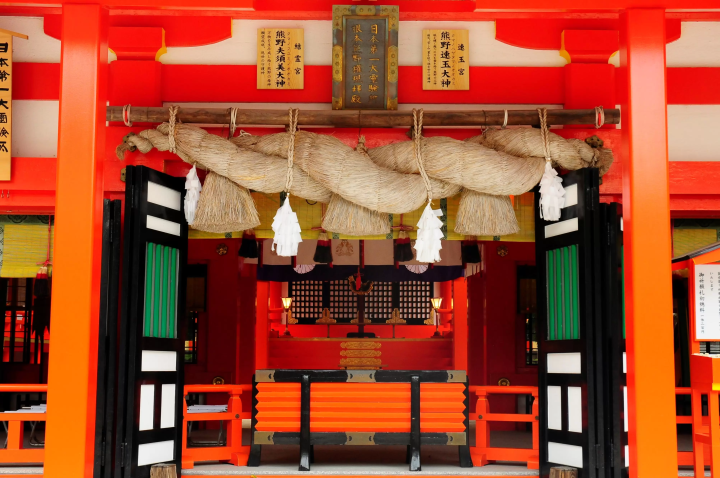
Festivals of Kumano Hayatama Taisha
Through ought the year, Kumano Hayatama Taisha hosts many festivals: Two of them are designated as "Important Intangible Folk Cultural Properties" of the Japanese government.
Kamikura Shrine's Fire Festival (February 6)
This festival, said to have originated when Emperor Jimmu was welcomed with torchlight, boasts a history of about 1,400-years.
At dusk, on the day of the festival, around 2,000 men dressed in white garments galled "Noboriko", gather around Gotobiki Rock. They transfer the sacred fire to their torches, illuminating the dark night in a fiery glow.
At 8pm, the closed mountain gate opens, and the climbers all cheer in unison as they run down the 538 steep stone steps. The sight is like a waterfall of flames cascading down, and is so powerful that it is sung in a local folk song ("Shingu Bushi") : "The Oto Matsuri is a men's festival, the mountain is a waterfall of fire, the descending dragon."
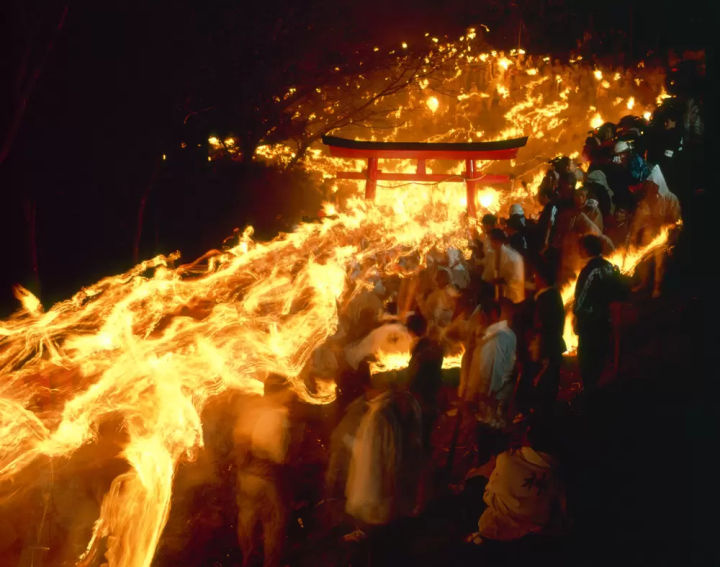
The children who ascend the mountain eat only white foods such as rice and tofu, wear white clothing, tie rough ropes around their stomachs, write prayers on torches, and purify their minds and bodies before the festival.
Kumano Hayatama Taisha Grand Festival (October 15–16)
Kumano Hayatama Taisha Shrine is located at the mouth of the Kumano River River. Its annual festival is held over two days around the Kumano River River: the "Shinbatogoshiki" ceremony on October 15th and the " Mifune Festival" on the following day, the 16th.
[Sacred Horse Procession Ceremony] October 15th
After welcoming the divine spirit of Kumano Hayatama Taisha Shrine to Asuka Shrine and performing a religious ceremony, the divine spirit is placed on a sacred horse and a procession led by the chief priest takes place. At the Otabisho, kagura and dance music are performed and prayers are played in the light of torches, creating a solemn atmosphere.
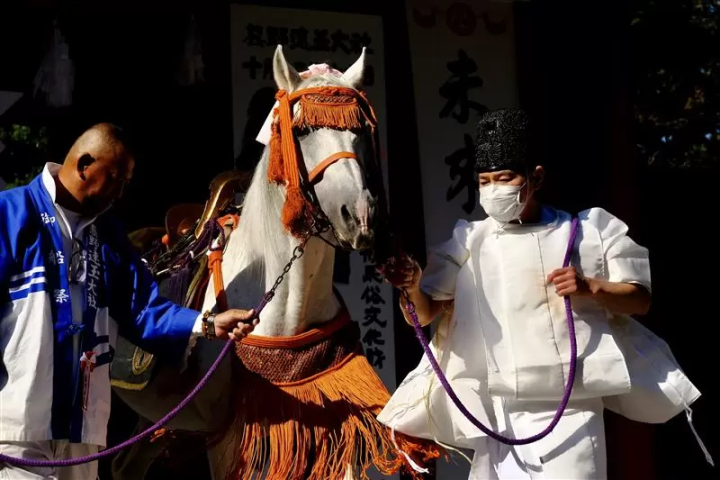
[Mifune Festival] October 16th
The portable shrine carrying the divine spirit arrives at the Kumano River and is transferred to a vermilion-painted "Shinkobune" boat. As the procession travels down the river alongside a fleet of boats carrying musicians and priests, a spectacular rowing race begins among nine fast boats, which circle Mifune three times over a distance of approximately two kilometers. As the procession progresses, men dressed in women's clothing and Aka perform the "Harihari Dance" to guide the sacred boat. Eventually, the procession arrives at the Otabisho, where the "Sugi no Kamiya" shrine is located, where the god was welcomed. After the Otabisho ritual is completed, the divine spirit is transferred back to the main shrine.
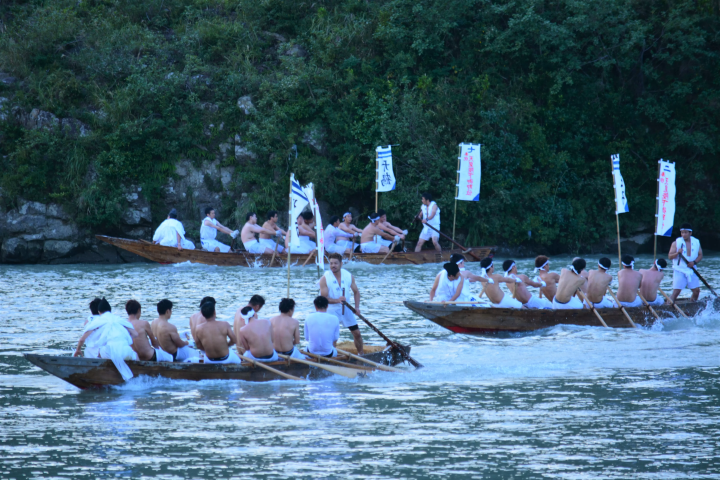
The Source of Prayer Revealed Through the Kumano Sanzan Pilgrimage
After visiting Kumano Hayatama Taisha, be sure to also visit Kumano Motomiya Taisha, Kumano Nachi Taisha, and Seiganto-ji Temple. If you tour the three mountains from Hayatama, which has been watched over by the flow of the Kumano River, you will be able to feel the connection between Kumano's nature, woven together by mountains, waterfalls, and rivers, and faith, as well as the deep prayers for it as a "land of rebirth."
-
2025.10.20
-
[Kumano Pilgrimage I] Kumano Hongu Taisha
2025.10.24
The contents on this page may partially contain automatic translation.

![[Kumano Pilgrimage II] Kumano Hayatama Taisha Shrineの画像](https://resources.matcha-jp.com/resize/720x2000/2025/09/01-243052.webp)
![[Wakayama Guide] Kumano Kodo](https://resources.matcha-jp.com/resize/200x2000/2025/10/06-246121.webp)
![[Kumano Pilgrimage I] Kumano Hongu Taisha](https://resources.matcha-jp.com/resize/200x2000/2025/09/26-245154.webp)
![[Kumano Pilgrimage III] Kumano Nachi Taisha Shrine/Hiraku Shrine](https://resources.matcha-jp.com/resize/200x2000/2025/09/10-243911.webp)
![[Kumano Pilgrimage IV] Seiganto-ji Temple on Mt. Nachi](https://resources.matcha-jp.com/resize/200x2000/2025/09/02-243066.webp)